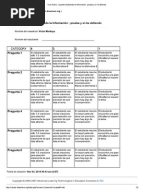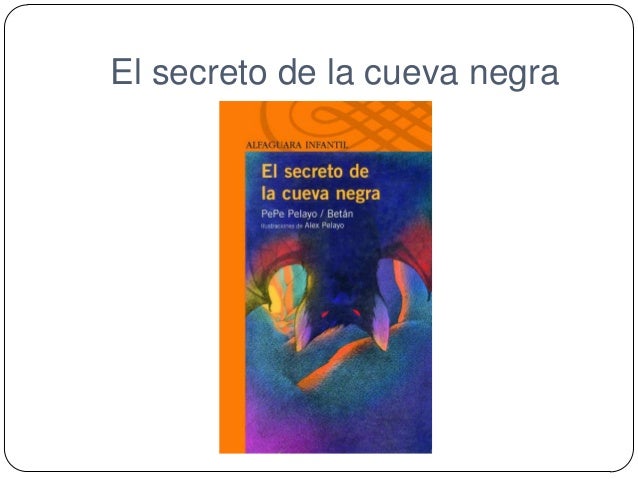

El Secreto de La Cueva Negra (Transcrito) - Pepe Pelayo - Download as PDF File (.pdf), Text File (.txt) or read online. The Chat Room_Maria Bentley_Richmond_primary readerss.pdf. Download pdf book by Pepe Pelayo - Free eBooks.
TRANSCRIPT
La Cueva Meaning
Copyright 1998 by Edward F. Frank Journal of Cave and Karst Studies, August 1998 101
Edward F. Frank-A Radiocarbon Date of 380 60BP for a Taino Site, Cueva Negra, Isla de Mona, Puerto Rico. Journal of Cave and Karst Studies 60(2): 101-102.
A RADIOCARBON DATE OF 380 60 BPFOR A TAINO SITE, CUEVA NEGRA,
ISLA DE MONA, PUERTO RICO
EDWARD F. FRANKDepartment of Geology and Geophysics, University of Minnesota, Minneapolis, MN 55455 USA
Charcoal fragments were collected from a mixed charcoal and bone deposit from a chamber in CuevaNegra, Isla de Mona Puerto Rico. Radiocarbon dating yielded a conventional 14C age of 380 60Radiocarbon Years before present. Considering the standard deviation in the 14C data, the range in pos-sible calendar dates is from 1480 to 1655 AD. This time period encompasses the first contact betweenTaino population and Europeans, and the subsequent removal of the last of the Taino from the island toPuerto Rico in 1578.
Charcoal fragments and bird bone samples were collectedfrom a mixed charcoal and bone deposit in a back chamber ofCueva Negra, Isla de Mona, Puerto Rico on August 1995 foridentification and radiocarbon dating. The sample area islocated in the distal end of a 40 m long by 5 m wide chamber.This chamber is located in complete darkness several hundredmeters, and around several bends, from the nearest entrance.The sample site itself consists of a 2.5 to 7.5 cm layer of mixedcharcoal, bird bone, and silt, atop a 15 cm bed of yellowish silt.Kaye (1959: 166) first described this deposit: Bones of whatmust be literally thousands of birds are contained in the floordeposit of the chamber and all of them are more or less inti-mately mixed with small charcoal fragments. The abundanceof charcoal fragments within the cave, it seems to the writer,cannot be ascribed to natural causes. Kaye (1959) reportedthese bones to be exclusively those of Audubons shearwater(Puffinus lherminieri). This identification is consistent withbird bones collected during the 1995 sampling. Kaye (1959:166) further suggested, based upon the location and character-istic of the deposit, the bird bones constitute a midden builtwith the refuse of many feasts, probably during Indian occu-pancy of the cave, and that the charcoal represents scatteredashes from the fires. Why the Audubons shearwater wasexclusively favored in these feasts is not known.
The charcoal and bone samples were collected from a 2-m-wide flowstone ledge on the eastern side of the chamber, andthe charcoal was submitted to Beta Analytic for radiocarbonanalysis (sample #Beta-86999, November 1995). Aftermechanical and chemical pre-treatment, less than one gram ofsuitable carbon remained. That carbon was analyzed withextended counting to enhance precision. The sample yielded aconventional 14C age of 380 60 Radiocarbon Years BP witha 13C of -29.6 relative to PDB-1 (Beta Analytic sample#Beta-86999, November 1995). The error represents the onestandard deviation statistic, 68% probability. Using the Stuvierand Pearson (1993) radiocarbon calibration curves, this 14C agecorresponds to a nominal calendar date of 1525 AD.Considering the standard deviation in the 14C data, the range in
possible calendar dates is from 1480 to 1655 AD. Collected from the top surface of the deposit, the sample
Here is list of thulasi background music audio/mp3 results. Torrent telugu movies free download. Note: Download Songs thulasi background music free only for review course, Buy Cassette or CD / VCD original from the album thulasi background music or use Personal Tone / I-RING / Ring Back Tone in recognition that they can still work to create other new songs.
may represent the youngest material in the sequence. The timeperiod is one of significant transition for the Taino populationof the island. It spans the first contact between the islandinhabitants and Europeans and the subsequent decimation andremoval of that native population. The island was first sightedby Columbus on November 22, 1493, while sailing across theMona Passage from Puerto Rico to Hispaniola on his secondvoyage to the New World (Morison 1944). Landfall on theisland was made later on the same voyage by Columbus onSeptember 24, 1494. Herrera y Tordesillas (1625, as translat-ed by Stevens 1740, reprinted 1973: 137) states, They nexttouchd at the Island Mona, which is ten leagues fromHispaniola, and eight from the Island of St. John, being sixleagues in compass, and on it grow most delicious melons, asbig as a jar of oil that will hold six quarts. The island wasdescribed by de las Casas as being very rocky, but containingmany holes filled with very fertile red soil. Cassava grew solarge in some of these holes that an Indian could only carry twoof them at a time on his back (Kaye 1959). Columbus provid-ed his ship with fresh water, melons, and cassava during hisshort stay from supplies provided by the Taino Indians inhab-iting the island (Wadsworth 1973). In 1508, Juan Ponce deLeon landed on the island with fifty men and spent severaldays there. They were supplied by the local population of 80Taino Indians with water, cassava, and cloth made from wildcotton.
Isla de Mona was recognized as a productive source of sup-plies and changed governorship several times in the early1500s. Soon, French pirates trying to disrupt this line of sup-ply subjected the island to raids. These raiding parties took agrave toll on the Taino Indians. In 1578, the remaining TainoIndian population of ~10-30, down from a high of 152 report-ed in 1517, was transferred to Puerto Rico to protect them(Wadsworth 1973). This 1578 date of removal of the TainoIndian population from the islands provides a possible upperlimit on the age of the bone and charcoal deposit.
102 Journal of Cave and Karst Studies, August 1998
A RADIOCARBON DATE OF 380 60BP FOR A TAINO SITE, CUEVA NEGRA, ISLA DE MONA, PUERTO RICO
Circumstantial evidence suggests that the bone and charcoaldeposit is of Taino Indian origin; however, Europeans couldhave been responsible.
Prior to contact with Europeans in 1494, the island hadbeen an important link in the travel patterns of the peoples ofthe Caribbean for possibly 2,000 years. It was a stopover onthe long voyage between Hispaniola and Puerto Rico. Therehave been two archaeological excavations on the island. Thefirst was the excavation of a village site in the Sardinera regionat the west end of the island. This village was likely the sameone found by Columbus in 1494. The village site is still evi-denced by shell heaps and potsherds in the area (Santana1973). The second excavation was conducted in Cueva de losCaracoles (Davila 1991). Stone implements, beads, amulets,and pieces of shell were recovered from the cave. Pictographsand petroglyphs are in several caves on the island (Frank1993). These are carved into the cave walls or flowstone orthey consist of black charcoal or mud drawings on the cavewalls. Two ball courts are present on the island at Bajura delas Cerezos and at Los Corrales de los Indios (Alegria 1983).The ball court at Los Corrales de los Indios is orientednorth-south and bounded by aligned stones at its margins. Itmeasures 27 m wide by 35 m long. The ball court at Bajura delos Cerezos is 27 m by 40 m. The archaeological evidenceclearly indicates that a population of Taino Indians were pre-sent on the island long prior to European contact. The eventmarked by the analyzed charcoal sample may represent the ter-minal phase of a long tradition on the island.
In Cueva Negra, Kaye (1959), described evidence of occu-pancy by man in the form of fragments of early Spanish colo-nial and Indian pottery, old glass, and conch shells (Strombusgigus). No evidence of this pottery or glass was found in thesample area. He also describes Indian petroglyphs and histor-ical writings found on the cave walls made by finger tracingmarks onto the soft limestone surface. Petroglyphs originallyfound in the walls adjacent to the bone and charcoal deposit inthe cave have been nearly destroyed by vandalism. Most of thelarge caves in the island were mined for guano in the late 1800sand early 1900s. This mining disturbed large areas in thesecaves and destroyed many potentially rich archaeological sites.Vandalism in easily accessible caves is also taking a toll. Sites,such as Cueva Negra, need to be adequately documentedbefore they are lost.
ACKNOWLEDGMENTS
I would like to thank the Cave Research Foundation, theUniversity of Minnesotas Department of Geology andGeophysics, and their George and Orpha Gibson Endowmentfor financial assistance in conducting field work on Isla deMona and laboratory processing of samples collected from theisland.
REFERENCES
Alegria, R.E. (1983). Ball courts and ceremonial plazas in the WestIndies. Yale University Publications in Anthropology 79: 1-185.
Davila, O. (1991). Cueva de las Caracoles, un sitio preceramico dela Isla de Mona. XVII Simposio de los recursos naturales, 13 y14 de Noviembre de 1991: 87-104.
Frank, E.F. (1993). Aspects of karst development and speleogenesisIsla de Mona, Puerto Rico: An analogue for Pleistocene speleo-genesis in the Bahamas. MS thesis, Mississippi State University:1- 282 pp.
Herrera y Tordesillas, A. de (1625). Historia general de los hechosde los castellano. Abridged English translation by Capt. JohnStevens, 1740, London: reprinted AMS Press, New York, NY, 6volumes.
Kaye, C.A. Icom ic 7100 service manual. (1959). Geology of Isla Mona, Puerto Rico, and notes onthe age of the Mona Passage. U.S. Geological Survey,Professional Paper 317C: 141-178.
Morison, S.E. (1944). Admiral of the ocean sea, a life of ChristopherColumbus. Little, Brown, and Company, Boston, MA: 1-679.
Santana, P.M. (1973). La Isla de Mona en los tiemposPrecolumbinos, Appendice M. Junta de Calidad Ambiental, LasIslas de Mona y Monito: Una evaluacion de sus RecursosNaturales e Historico, volume 2: M1-M9.
Stuvier, M. & Pearson, G.W. (1993). High-precision bidecadal cal-ibration of the radio-carbon time scale, AD 1950-500 BC, and2500-6000 BC. Radiocarbon 35 (1): 1-23.
Wadsworth, F.W. (1973). The historical resources of Mona Island,Appendix N. Junta de Calidad Ambiental, las Islas de Mona yMonito: Una evaluacion de sus recursos naturales e historicos,volume 2: N1-N37.